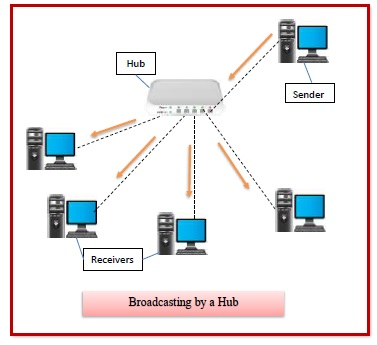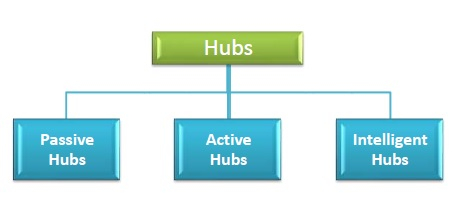
 Data Structure
Data Structure Networking
Networking RDBMS
RDBMS Operating System
Operating System Java
Java MS Excel
MS Excel iOS
iOS HTML
HTML CSS
CSS Android
Android Python
Python C Programming
C Programming C++
C++ C#
C# MongoDB
MongoDB MySQL
MySQL Javascript
Javascript PHP
PHP
- Selected Reading
- UPSC IAS Exams Notes
- Developer's Best Practices
- Questions and Answers
- Effective Resume Writing
- HR Interview Questions
- Computer Glossary
- Who is Who
What are Hubs in Computer Network?
Hubs are networking devices operating at a physical layer of the OSI model that are used to connect multiple devices in a network. They are generally used to connect computers in a LAN.
A hub has many ports in it. A computer which intends to be connected to the network is plugged in to one of these ports. When a data frame arrives at a port, it is broadcast to every other port, without considering whether it is destined for a particular destination device or not.

Features of Hubs
A hub operates in the physical layer of the OSI model.
A hub cannot filter data. It is a non-intelligent network device that sends message to all ports.
It primarily broadcasts messages. So, the collision domain of all nodes connected through the hub stays one.
Transmission mode is half duplex.
Collisions may occurs during setup of transmission when more than one computers place data simultaneously in the corresponding ports.
Since they lack intelligence to compute best path for transmission of data packets, inefficiencies and wastage occur.
They are passive devices, they don’t have any software associated with it.
They generally have fewer ports of 4/12.
Types of Hubs
Initially, hubs were passive devices. However, with development of advanced technology, active hubs and intelligent hubs came into use.

Passive Hubs − Passive hubs connects nodes in a star configuration by collecting wiring from nodes. They broadcast signals onto the network without amplifying or regenerating them. As they cannot extend the distance between nodes, they limit the size of the LAN.
Active Hubs − Active hubs amplify and regenerate the incoming electrical signals before broadcasting them. They have their own power supply and serves both as a repeater as well as connecting centre. Due to their regenerating capabilities, they can extend the maximum distance between nodes, thus increasing the size of LAN.
Intelligent Hubs − Intelligent hubs are active hubs that provide additional network management facilities. They can perform a variety of functions of more intelligent network devices like network management, switching, providing flexible data rates etc.

